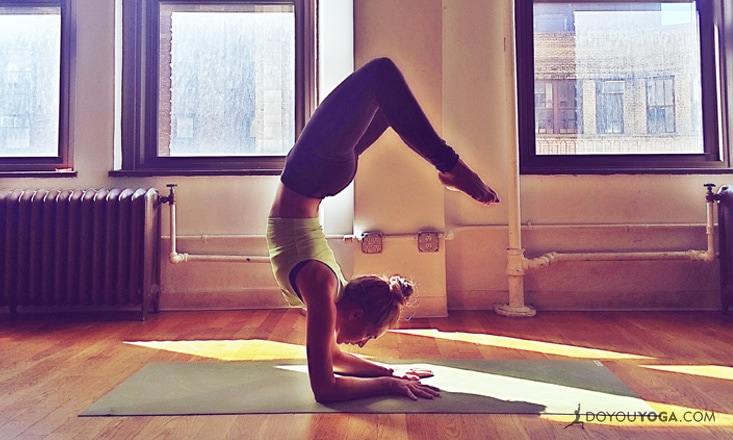Forearm Stand (or Pincha Mayurasana) is inarguably one of the toughest yoga poses to nail. This arm-balancing inversion requires flexibility, strength, alignment and a solid foundation. Without a strong base, we risk compromising the soundness of the pose. Without correct form, we risk losing the security of the pose — and if you’re going to have a crash landing, it isn’t as easy as cartwheeling out of handstand.
To help you build up strength especially if you’re new to yoga, it’s a good idea to sign up to this free 30 Day Yoga Challenge. Via guided daily practice, you’ll soon get used to distributing your weight evenly in each pose.
Try mastering these steps before even attempting Forearm Stand to see if you’re ready to take flight. These poses also serve as a warm-up if you already have Forearm Stand in your repertoire.
1. Open Hamstrings and Hips
Open hamstrings and hips are key to a graceful Forearm Stand and will facilitate the transitory process of getting into the final pose.

What to do?
Start in a Low Lunge to stretch the hip flexors. Stay for 8 deep breaths and then straighten your front leg while shifting the hips back into a hamstring stretch.
Bring your hands to blocks on either side of the front leg or to the floor. Stay for 8 deep breaths. Repeat (on both sides) until you feel an openness in the hips and hamstrings.
2. Core Core Core
Whether hopping or floating into Forearm Stand, the core plays a major role. Without a solid core we risk an unstable base and uncontrollable body. The core is also the glue that holds the final position in place.
What to do?
There are many core exercises, but to practice balancing on the forearms, we’ll focus on Forearm Plank. Bring the forearms to the ground with your shoulders directly above your elbows, and your elbows in line with your wrists. Press the palms into the floor and step the feet back until you create a straight line in your body from head to heels. Push back through your heels and reach the crown of your head forward, elongating your spine and engaging the core.
3. Dolphin for Foundation
Dolphin Pose provides the building blocks for Forearm Stand by illustrating its correct foundation and conditioning the targeted muscles. Forearm Stand demands a tremendous amount of upper back strength and shoulder girdle flexibility, both of which can be achieved through Dolphin.
What to do?
Starting in a Forearm Plank with the arms at a 90 degree angle, lift your hips up and back like you would for Down Dog. Reach your chest toward the thighs and walk your feet in a few inches. Your back should be flat with your tailbone lengthening up toward the ceiling. Keep your shoulders away from your ears, which will prevent collapsing of the chest, and then elongate your neck. Make sure your elbows don’t roll outward or your hands inward – Forearm Stand will require a sturdy forearm/elbow base at a 90 degree angle.
4. Leg Raised Dolphin
This is where the hamstring and hip stretches should come in handy. When we eventually hop into forearm stand, we want to travel as little as possible for a smooth and steady transition. The ability to reach one leg up far toward the ceiling will decrease the amount of “kicking” and “jumping” needed and makes it easier on the core to draw the opposite leg up from the ground.
What to do?
From Dolphin Pose, start to lift one leg as high as possible. Much like 3-Legged Dog/Down Dog Splits, we want the hips squared to the ground, which will help the alignment of your Forearm Stand. To check, make sure your toes are pointed straight down to the floor and not splayed out to the side. Otherwise, kicking up into Forearm Stand with an open hip could cause the body to naturally gravitate away from the midline (aka fall!). Symmetry is key!
5. Backbend for Falling
There’s really no easy way to fall out of Forearm Stand. But a pliable body will help if you start to banana backward. You should be prepared for this to happen at one point or another because, well, it will. Before you know it you will have landed in forearm wheel. And hopefully you were able to use that strong core to control the landing too.
What to do?
From full Wheel Pose bend both elbows away from the body while slowly and lightly sitting the crown of your head on the ground. Place one forearm on the ground at a time. Palms should be pressing against the floor with fingertips facing the heels. Keep your elbows and forearms parallel, draw the chest up toward the ceiling, and you’re in Forearm Wheel!
If this all clicks with your practice, then you’re ready to give Forearm Stand a go! Just remember to stretch first, then check your foundation and alignment, and finally have a safe exit strategy.
When you’re ready for Forearm Stand:
Start in Dolphin Pose being mindful of your foundation. Next, walk your feet in as close toward your face as possible (you will be on your tip-toes) to ease the process of getting up and into Forearm Stand. Look between your forearms and raise one leg as you would for the One-Legged Dolphin Pose. Engage your core and start to bounce on the ball of your grounded foot. Eventually, bounce off of that bottom foot drawing the leg up to meet the other in the air, in full Forearm Stand. Once up, keep pushing up through your arms and shoulders, and flex through your toes reaching towards the ceiling. Voila!







